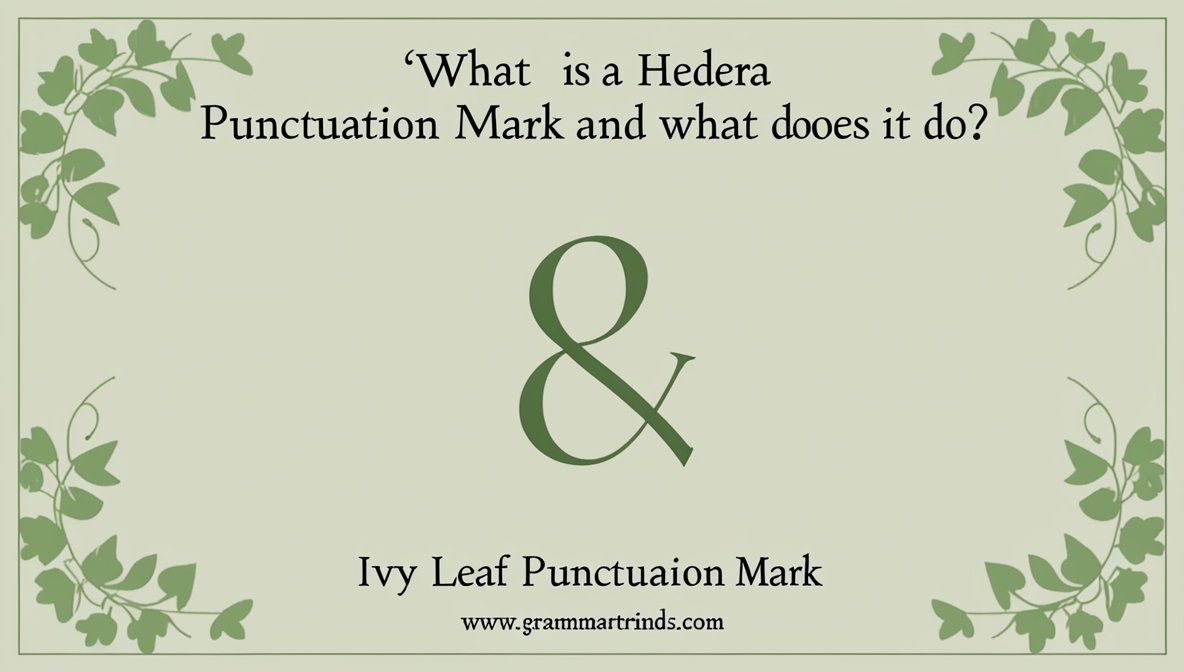If you’ve ever stumbled across a small leafy symbol (❦) nestled between paragraphs or sections of text, you’ve seen the Hedera punctuation mark. Often overlooked, this decorative punctuation also known as the Hedera symbol, fleuron, or ivy leaf punctuation has roots that go way back to ancient punctuation marks used in early texts.
Although it’s not a punctuation mark in the conventional sense, it plays an important role in typographic design, paragraph separation, and the visual rhythm of written content. Let’s uncover the story of this elegant symbol, its history, and how you can use it today.
What Is the Hedera Punctuation Mark?
The Hedera punctuation mark, also referred to as a fleuron or ivy leaf, is a stylized typographic symbol used to decorate or divide sections of text. Visually, it resembles a small leaf or floral design: ❦.
In historical texts, it was more than just decoration. It helped guide the reader’s eye through dense paragraphs, acting as a paragraph break symbol long before the days of modern formatting.
It’s important to note that the Hedera isn’t used for grammar or sentence structure. Instead, it lives in the realm of typographic marks, where aesthetics and readability meet.
Where Did the Hedera Come From? A Brief History
The Hedera traces back to early Latin texts and ancient Greek texts, where it was used by scribes in hand-copied manuscripts. Its name comes from the Latin word hedera, meaning ivy. This symbol became especially popular during the mid-15th century, with the rise of the printing press.
Back then, printers needed a way to fill blank spaces or indicate transitions. They turned to decorative glyphs like the Hedera and others in the punctuation history that faded away over time. While some punctuation, like the pilcrow (¶) and asterisk (*), evolved into mainstream use, the Hedera quietly moved to the punctuation graveyard though it still finds occasional revival in modern typography.
How Is the Hedera Used Today?
In modern writing and design, the Hedera appears in:
- Poetry collections
- Wedding invitations
- Books with vintage layouts
- Artistic design projects
- Stylish websites
Its purpose today is simple: visual separation with elegance.
It’s a go-to choice for designers who want a decorative typographic element that feels both historical and graceful. You might see it used in place of traditional bullet point marks or to break up long-form content with floral scrolls or scroll and flower designs in text.
How to Insert the Hedera Symbol (❦)
Here’s how to use it in your digital documents:
| Platform | Steps to Insert |
|---|---|
| Windows | Use Character Map > Search “Fleuron” |
| Mac | Press Control + Command + Space > Symbols |
| HTML / Web | ❦ or ❦ for ❦ |
| Unicode | U+2766 (❦), U+2767 (❧) |
| Design Software | Glyph panel in Adobe Illustrator or InDesign |
Make sure the font supports special characters and typography symbols like the Hedera. Fonts such as Georgia, Times New Roman, and Garamond often include it.
Hedera vs Other Symbols – What’s the Difference?
Let’s compare the Hedera to other familiar and decorative punctuation marks:
| Symbol | Name | Purpose | Use Today |
|---|---|---|---|
| ❦ | Hedera | Decorative separator | Poetry, design, ornamental text |
| ❧ | Fleuron (alt) | Variant of Hedera, horizontal leaf | Design layouts, digital type |
| * | Asterisk | Footnotes, emphasis, lists | Common punctuation |
| ¶ | Pilcrow | Paragraph indicator | Word processing, editing marks |
| ⁂ | Asterism | Section divider | Rarely used, literary works |
When Should You Use a Hedera (And When You Shouldn’t)?
Use the Hedera punctuation mark when:
- You want a decorative break in poetry, stories, or formal design
- You’re designing wedding or event stationery
- You want to separate ideas in a book or essay with a historical feel
Avoid using it in:
- Academic or technical writing
- Legal or professional documentation
- Modern, minimalist layouts
Like all decorative punctuation marks, less is more. One well-placed Hedera can add charm too many and your page starts to feel cluttered.
Is the Hedera Obsolete or Making a Comeback?
In terms of grammar? Yes, it’s obsolete. In the world of graphic design and creative publishing? It’s still alive and quietly thriving.
While it won’t replace a comma or period, the ivy leaf punctuation remains a symbol of literary beauty, harkening back to the days of early Latin and Greek punctuation. It exists today more as an artistic echo than a functional mark but that doesn’t mean it’s useless.
Conclusion
The Hedera punctuation mark is more than just a pretty leaf. It represents a piece of typographic history that continues to influence decorative punctuation and floral design punctuation in modern creative work.
Whether you’re a typographer, a designer, or just a language enthusiast, the Hedera offers a reminder: even punctuation can be beautiful.
So the next time you’re laying out a page, maybe drop in a Hedera. Just once. See what happens.
Frequently Asked Questions (FAQs)
What is the Unicode for the Hedera symbol?
The Unicode for the Hedera symbol is U+2766 (❦).
Is Hedera still used in modern writing?
It’s mostly used for decorative purposes in design or creative projects.
What’s another name for the Hedera punctuation mark?
It’s also known as a fleuron, ivy leaf, or floral heart.
